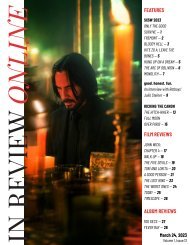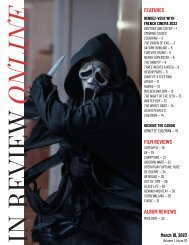InRO Weekly — Volume 1, Issue 1
Create successful ePaper yourself
Turn your PDF publications into a flip-book with our unique Google optimized e-Paper software.
Adapted from Alberto Moravia's 1951 novel of the same name, the film is, in essence, a character study of an easily persuadable yet<br />
deeply conflicted and profoundly disaffected also-ran named Marcello Clerici (played with remarkable complexity by Jean-Louis<br />
Trintignant). After a childhood marred by neglect, dysfunction, and a traumatic episode of sexual abuse, Marcello yearns for a "normal"<br />
life in an Italy that has fallen to fascism. His beliefs may not run deep, but his commitment does, and he goes through the motions of<br />
assimilating into fascist society <strong>—</strong> impassive church confessions where he comes clean about all manner of sin, an unenthusiastic<br />
marriage to a petit bourgeois putz, conscientious service for the fascist secret police <strong>—</strong> before being sent to Paris to assassinate his<br />
exiled former professor, Luca Quadri (Enzo Tarascio). Since fleeing Italy, Quadri has partaken in anti-fascist activities, and the Italian<br />
authorities believe they need to make an example of him. True to form, Marcello decides to take his wife along so he can get his<br />
honeymoon over with as well, but once they arrive, he soon begins an affair with Quadri's young wife, Anna (Dominique Sanda), who,<br />
upon learning of his motives, openly criticizes his allegiance to fascism, begging him not to hurt her and her husband.<br />
Sitting in a car on his way to finally finish the job for which he was sent to France, Marcello ponders his life and the circumstances<br />
that put him where he is. Bertolucci presents these memories with a subtle, dreamlike haziness that is emphasized by fluid camera<br />
movements and a vibrant, high-contrast color scheme. Even though its visuals have earned particular praise, The Conformist<br />
functions as a kind of Gesamtkunstwerk: image, sound, editing, script, and performance all combine into something transcendently<br />
cinematic. Shot by legendary cinematographer Vittorio Storaro, the film frames its characters against the cold, imposing architectural<br />
Rationalism popular under Mussolini's rule <strong>—</strong> in particular, the marble-benched asylum which houses Marcello's<br />
2

















